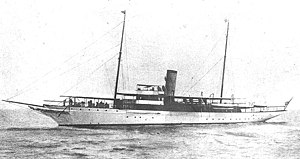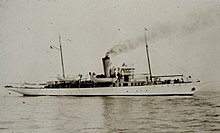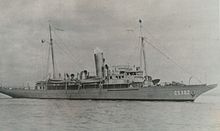USS Lydonia
 The civilian steam yacht SS Lydonia II prior to her 1917 acquisition by the United States Navy.
| |
| History | |
|---|---|
| Name | USS Lydonia |
| Namesake | Modification of Lydonia II, the ship's civilian name when acquired |
| Operator | United States Navy |
| Builder | Pusey and Jones, Wilmington, Delaware |
| Laid down | April 1911 |
| Launched | 25 July 1911 |
| Completed | 1912 |
| Acquired | 21 August 1917 |
| Commissioned | 27 October 1917 |
| Decommissioned | 7 August 1919 |
| Fate | Transferred to U.S. Coast and Geodetic Survey 7 August 1919 |
| Notes | Served as civilian yacht SS Lydonia II 1912–1917, owned by William A. Lydon |
| Name | USC&GS Lydonia |
| Namesake | U.S. Navy name retained |
| Operator | U.S. Coast and Geodetic Survey |
| Acquired | 7 August 1919 |
| Commissioned | 1919 |
| Decommissioned | 1947 |
| Identification | CS 302 |
| General characteristics (as U.S. Navy vessel) | |
| Type | Patrol vessel |
| Tonnage | 497 GRT |
| Length | 181 ft (55 m), 214 ft (65.2 m) length overall |
| Beam | 26 ft (7.9 m) |
| Draft | 11 ft 5 in (3.48 m) |
| Propulsion | Steam engine |
| Speed | 12 knots (22 km/h; 14 mph) |
| Complement | 34 |
| Armament |
|
| General characteristics (as U.S. Coast and Geodetic Survey vessel) | |
| Type | Coastal survey ship |
| Length | 180.5 ft (55.0 m) |
| Beam | 26 ft (7.9 m) |
| Draft | 11.5 ft (3.5 m) |
| Propulsion | Steam engine |
USS Lydonia (SP-700) was
Construction
Lydonia II was constructed for William A. Lydon,
Description (as built)
Sources agree, using similar or the same measurement methods, for dimensions except for the yacht's length. The length overall is given as 212 ft 6 in (64.8 m); length on load waterline of 170 ft 6 in (52.0 m)[2] and length overall 214 ft (65.2 m)[5] with 181 ft (55.2 m)[4][5] being a different method of measurement used in contemporary government sources that also state length overall.[note 2] The beam of 26 ft (7.9 m) with draft at 11 ft 5 in (3.5 m) agrees within inches.
Hull
The steel hull incorporated five water tight bulkheads and three non-watertight bulkheads that extended from keel to the main deck. One transverse and two side bunkers provided storage for 125 tons of coal loaded through four coaling scuttles with water tight openings on the main deck. Water tanks with 5,000 US gallons (19,000 L; 4,200 imp gal) capacity were fitted within the hull.[2]
Interior spaces
The
The forward portion of the forecastle, beyond the collision bulkhead, was a paint locker reached from the forecastle deck by a hatch and ladder. Aft of the collision bulkhead on the berth deck were quarters with folding steel pipe berths for fifteen men and a stateroom with two fixed berths for quartermasters. Those quarters were reached by a hatch in the forecastle deck and a hatch in the berth deck led to a wash room and toilet and four additional steel pipe berths. Forward of that lower forecastle crew space was the chain locker adequate to store 150 fathoms (900 ft; 270 m) of chain. Aft of the forecastle crew space were the officer's quarters reached by a separate forecastle companion hatch to a lobby off of which were six officer's staterooms and one bath.[2]
Between the officer's quarters and the bunker and machinery housing on the berth deck were two large staterooms using the entire width of the yacht, a smaller stateroom and a bath room and lobby with a curved stair to the main deck. These owner's spaces were finished in African mahogany; natural grain and rubbed to a finish for the lobby and painted white for the staterooms. The rooms were furnished in canopy beds specially designed for the purpose. The bathroom contained a tub, lavatory, toilet and was lighted and ventilated by a skylight. Aft of the machinery space amidship were the guest's quarters of six single staterooms, one large double stateroom extending the width of the yacht with a skylight, and three bath rooms. They connect by a longitudinal passageway with stairs to the library in the deckhouse on the main deck. They were finished in a similar manner to the owner's spaces with African mahogany.[2]
The main deck deckhouse forward contained the dining saloon filling the full width with views forward and to the sides. The saloon was finished in carved and paneled teak with the ceiling in dull guilt and furnished with a large polished teak round table that could extend to seat sixteen people. Aft of the dining saloon on the port side were pantry and galley. Various service spaces were located forward of the engine room casing that had a large observation window fitted for viewing the machinery from the starboard deck passage. The after end of the deck house contained first a roomy library fitted with bookcases with a domed skylight above for light. Aft was a music room through which the main mast passed that was furnished with comfortable seating with the stair to the guest's staterooms in the aft starboard corner. All was paneled in African mahogany with gilt ceilings.[2]
Engineering
The main engine was a triple expansion type with cylinders of 16 in (41 cm), 26 in (66 cm), and 30 in (76 cm) with 24 in (61 cm) stroke with 1,000
Two General Electric generating sets, 10 and 4 kilowatts (13.4 and 5.4 hp), provided electricity for living and operating spaces as well as a 14 in (36 cm) searchlight on the bridge. Refrigeration machinery was not immediately fitted but provisions for such machinery had been made in construction of a large
The U.S. Navy purchased Lydonia II from Lydon on 21 August 1917 for $170,000 for use as a
After repairs and target practice off
Mediterranean operations
Lydonia spent the early months of 1918 protecting Allied Mediterranean supply convoys from attacks by Imperial German Navy submarines (U-boats). She made two attacks on enemy submarines in February 1918 but did not sink them.[6]
On 8 May 1918, Lydonia was steaming with a convoy from Bizerte, Tunisia, to Gibraltar when the German submarine SM UB-70 torpedoed and sank one of the convoy's ships, the British merchant ship SS Ingleside. Lydonia joined the British Royal Navy destroyer HMS Basilisk in counterattacking UB-70 beginning at 17:35, with the two ships making coordinated depth charge attacks. After 15 minutes, Lydonia and Basilisk ceased their attack and turned their attention to rescuing the survivors of Ingleside. Heavy seas prevented an immediate assessment of possible damage to UB-70, but later evaluations credited Lydonia and Basilisk with sinking the submarine.[6]
For the rest of the war, Lydonia continued her escort operations between Bizerte and Gibraltar. After the conclusion of the war on 11 November 1918, she called at the Azores and Caribbean ports on her way back to the
Decommissioning and transfer
The U.S. Navy
United States Coast and Geodetic Survey service


In Coast and Geodetic Survey service, Lydonia became the coastal
On several occasions during her long Coast and Geodetic Survey career, Lydonia assisted mariners in distress. On 7 August 1921, she assisted in helping survivors and searching for bodies in the wreck of the steamboat SS Alaska on Blunt's Reef off the coast of northern California. On 17 January 1927, she came to the aid of the United States Coast Guard Cutter Modoc, which was aground at the entrance to the Cape Fear River in North Carolina, joining a tug in refloating Modoc at high tide. In May 1927, she and the survey ship USC&GS Hydrographer were sent to Memphis, Tennessee, to help victims of the great Mississippi River flood of that year.[8]
On 23 August 1933, Lydonia was with the Coast and Geodetic Survey survey ships
Along with the rest of the Coast and Geodetic Survey's ships, Lydonia operated in support of U.S. Navy requirements during the participation of the United States in World War II (1941–1945), although she remained a part of the Survey during the war.
The Coast and Geodetic Survey retired Lydonia from service in 1947.
Commemoration
Lydonia Canyon, an undersea canyon in the Atlantic Ocean off the Gulf of Maine on the slope of the Georges Bank, is named for USC&GS Lydonia.[10]
Footnotes
- ^ Lydonia I was possibly confusingly Hull #338.
- ^ The 181-foot measurement, compared to the others, fits within the range of and is likely the registered length method of measurement.
- ^ Lydon died on 28 October 1918 only days before war's end and his yacht had finished war service.
References
- ^ a b c d Hagley Library. "Building the Lydonia II". Pusey and Jones Collection. Hagley Museum and Library, Greenville, Delaware. Retrieved 27 February 2012.
- ^ a b c d e f g h i j k l Reed, A.S. Jr. (February 1913). "The American-Built Steam Yacht Lydonia". International Marine Engineering. Vol. 18, no. 2. pp. 66–68. Retrieved 11 September 2018.
- ^ T. Colton (12 September 2014). "Pusey & Jones, Wilmington DE". Shipbuilding History. Retrieved 11 September 2018.
- ^ a b Department of Commerce, Bureau of Navigation (1913). Forty Fifth Annual List of Merchant Vessels of the United States; Part VI. Washington, D.C.: U.S. Government Printing Office. p. 80. Retrieved 11 September 2018.
- ^ a b c d e Construction & Repair Bureau (Navy) (1 November 1918). Ships' Data U.S. Naval Vessels. Washington D.C.: U.S. Government Printing Office. pp. 290–295. Retrieved 11 September 2018.
- ^ a b c d e f g Naval History And Heritage Command (29 July 2015). "Lydonia". Dictionary of American Naval Fighting Ships. Naval History And Heritage Command. Retrieved 11 September 2018.
- ^ Director, United States Coast And Geodetic Survey (1920). Annual Report Of The Director, United States Coast And Geodetic Survey To The Secretary Of Commerce For The Fiscal Year Ended June 30, 1920. Washington, D.C.: U.S. Government Printing Office. p. 60.
- ^ "Lifesaving and the Protection of Property by the Coast and Geodetic Survey 185–1937". National Oceanic & Atmospheric Administration (NOAA). 8 June 2006. Retrieved 11 September 2018.
- ^ NavSource Online: Section Patrol Craft Photo Archive USC&GS Lydonia (CS 302) ex-USS Lydonia (SP 700) Accessed 14 November 2023.
- ^ NOAA Coast Survey: A Monumental History
